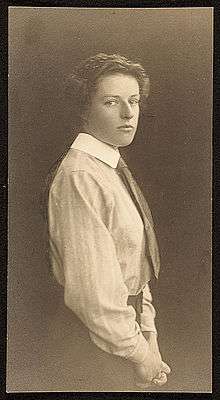Grace Mott Johnson
| Grace Mott Johnson | |
|---|---|
 Portrait of Grace Mott Johnson | |
| Born |
July 28, 1882 New York, NY |
| Died |
March 12, 1967 (aged 84) Rochester, NY |
| Nationality | American |
| Spouse(s) | Andrew Michael Dasburg (married 1909-1922) |
Grace Mott Johnson (1882–1967) was an American artist married to Andrew Michael Dasburg.[1]
Biography
Early life
Johnson's mother died two years after she was born, so she was raised by her father. Her early years were spent being home-schooled on a farm in Yonkers, New York.[2] She began drawing when she was four years old, and when the family moved to a farm in 1900 she enjoyed sketching horses and other farm animals. At the age of 22, she left home to study at the Art Students' League with sculptors Gutzon Borglum and James Earle Fraser, and also attended Birge Harrison's painting class in Woodstock. Throughout her career she would sculpt animals from memory, as she was adamant that animals could not be sketched. She would often attend circuses and farms for inspiration. In fact, for many summers she followed traveling circuses to observe the animals.[1][3]
Career
In 1909, Johnson and Andrew Dasburg went to Paris and joined the modernist circle of artists living there, including Morgan Russell, Jo Davidson, and Arthur Lee. During a trip to London that same year they were married. Johnson returned to the United States early the next year, but Dasburg stayed in Paris where he met Henri Matisse, Gertrude and Leo Stein, and became influenced by the paintings of Cézanne and Cubism. He returned to Woodstock, New York in August and he and Johnson became active members of the artist community. In 1911, their son Alfred was born. Both Dasburg and Johnson showed several works at the legendary Armory Show in 1913, and Dasburg also showed at the MacDowell Club in New York City, where he met the journalist and activist John Reed who later introduced him to Mabel Dodge (Luhan), a wealthy art patron and lifelong friend. In 1914, Dasburg met Alfred Stieglitz and became part of his avant-garde circle. Using what he had seen in Paris, Dasburg became one of the earliest American cubist artists, and also experimented with abstraction in his paintings.[1]
Dasburg and Johnson lived apart for most of their marriage. By 1917, they had separated and Dasburg began teaching painting in Woodstock and in New York City. In 1918, he was invited to Taos, New Mexico by Mabel Dodge, where she was associated with Dodge's artist colony.[2] Returning in 1919, Johnson joined him there for a period of time. Also in 1919, Dasburg was one of the founding members of the Woodstock Artists Association with John F. Carlson, Frank Swift Chase, Carl Eric Lindin, and Henry Lee McFee. In 1922, Dasburg and Johnson divorced.[1]
Grace Mott Johnson lived in the Johnson family home in Yonkers, New York during the 1920s, moving to Pleasantville, New York in 1927.[3] In 1924 she went to Egypt to study ancient Egyptian sculpture. In 1929 she had a solo exhibition of her sculpture and drawings at the Art Gallery of the Museum of New Mexico.[4] During the 1930s, she became a civil rights activist. She had many friends in the arts community in Harlem and was an active representative of NAACP.[5][6] She produced very little art during the last twenty years of her life.[1]
Writings by Johnson were also found which included two brief autobiographical writings which described her early life. These included what it was like living on a farm, her interests in art and art education. She also worked on a home-made magazine called "The Johnson Monthly" which she made with her siblings, the illustrations in the magazine were done by Johnson. Additionally, she had written poems, writings about civil rights, and loose diary-style writings which expressed her thoughts. Her sketchbooks mainly included charcoal and pencil drawings of animals, landscapes, and other designs. Preliminary sketches of her animal sculptures were also included as well as sketches of her son Alfred Dasburg.[1]
Awards
In 1917, Johnson was awarded the Macmillan Sculpture Prize at New York City's National Association of Women Painters and Sculptors. She was also awarded the Joan of Arc Medal in 1927.[7]
Legacy
Her artwork is still highly valued within the art community, with it going above estimates in auction. Her sculpture of a Grey hound sold for $3,884 at auction in 2006, which was 56% above the estimate. Her portrait of a hunting dog sold for 549% above estimated auction.[8] Her bronze figure of a lamb sold for $2,420 when the estimate was $1,000-$1,500.[9]
References
- 1 2 3 4 5 6 "Andrew Dasburg and Grace Mott Johnson papers, 1833-1980, bulk 1900-1980 Finding Aid". Smithsonian Archive of American Art. Retrieved 29 July 2011.
- 1 2 Niederman, Sharon (1988). A Quilt of Words: Women's Diaries, Letters & Original Accounts of Life in the Southwest 1860 - 1960. Berlin: Big Earth Publishing. p. 153. doi:10.1007/b62130. ISBN 978-1-55566-047-5. (Google Books)
- 1 2 "Local Sculptor Takes Prize In National Exhibit". Archives of American Art. Retrieved 29 July 2011. (direct link to article scan)
- ↑ "Exhibition of sculpture and drawings by Grace Mott Johnson : Art Gallery of the Museum of New Mexico Santa Fe, August, 1929". Worldcat. OCLC. Retrieved 24 March 2016.
- ↑ "Pleasantville Sculptor Wins Prize in Exhibit of National Association". Archives of American Art. Retrieved 29 July 2011. (direct link to article scan)
- ↑ "Local Artist Will Leave for Santa Fe". Archives of American Art. Retrieved 29 July 2011. (direct link to article scan)
- ↑ Heller, Jules; Heller, Nancy G. (2013-12-19). North American Women Artists of the Twentieth Century: A Biographical Dictionary. Routledge. ISBN 9781135638894.
- ↑ "Grace Mott Johnson (British, 1882 - 1967)". www.mutualart.com. Retrieved 2017-04-24.
- ↑ "GRACE MOTT JOHNSON (1882-1967)". www.christies.com. Retrieved 2017-04-24.
External links
![]()